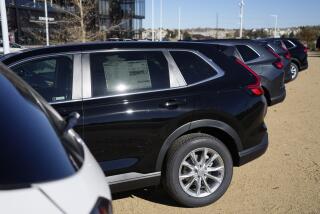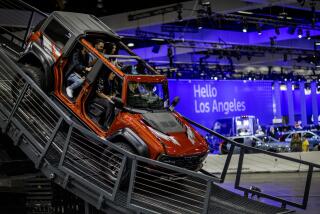The Car of the Future
- Share via
CHANCES ARE THAT in the next 25 years, Los Angeles won’t lose its ardor for the automobile. But the cars in which we spend so much of our time will be smaller, more efficient, more automated and more personalized, industry experts say.
“Vehicles will become more suited to the needs of each individual,” says John Schinella, director of General Motors’ Advanced Concepts Center in Thousand Oaks. “Some will be more utilitarian, more pointed as to what their uses are, but shapes, sizes and needs will be vastly different.”
“I think you’ll see a lot of special-purpose vehicles,” agrees David Turner, director of Advanced Concepts Design for the Ford Motor Co. “There’ll still be large and small cars, but there’ll be a greater variety of vehicles available, including extremely small commuter vehicles.”
For instance, Schinella predicts, we may one day be able to drive around Los Angeles in a “sports-utility” vehicle that can go from being a two-seat sports car to a beach buggy--thanks to a plug-in module. And, Turner says, the variety of models available in these “niche” vehicles will be astounding. For example, consumers will be able to choose from scores of van models--all different. These could include a “starter” van for families, a commuter van that would be the “Lear Jet of the highways,” a sedan that could convert into a van and even a van that would handle “like a Mark VII.”
Turner says the car of the future will be defined by increased efficiency. By 2013, the engine and mechanical parts of the car will have become smaller, he predicts, leaving more space for people and cargo. Schinella sees autos 25 years from now as slimmer and taller than cars today, with more spacious interiors. Turner believes that aerodynamics will “always drive the shape of the car” and that auto interiors will be “infinitely adjustable.” And, he adds, tremendous progress will have been made in automobile safety.
In 25 years, today’s new technology will have become standard equipment, both designers agree. Chief among these developments will be a central computer in the car that will control a number of devices. A sonar shield, for example, will automatically brake the car when it comes too close to another. If something malfunctions, diagnostic features will tell the driver what’s wrong. Autos will also come equipped with electronic navigation or map systems. Once the driver programs a destination, the system will pick the fastest route, taking into account traffic information, then give the driver the estimated time of arrival, continually plotting the car’s position on a map.






